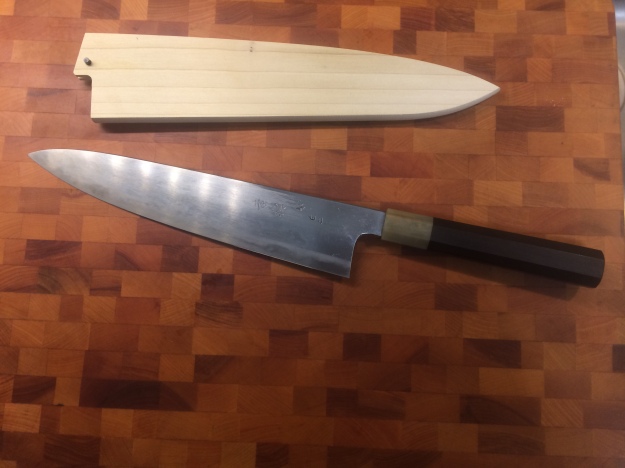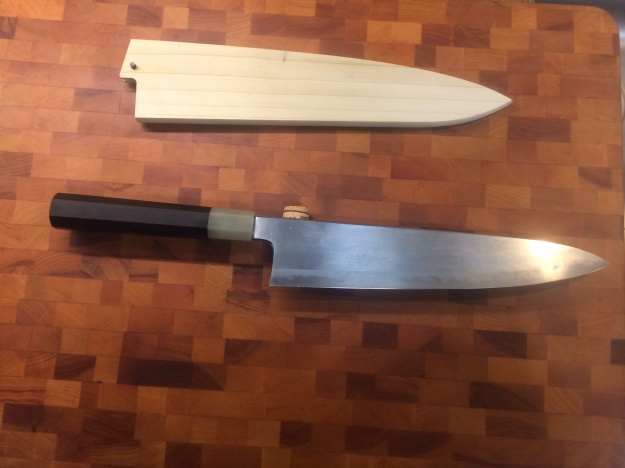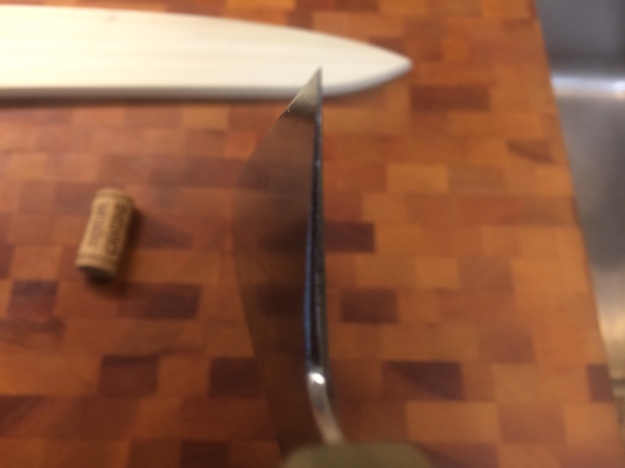It is hard to write a review of a Konosuke Fujiyama. The Fujis are some of the highest regarded, widely used knives on the upper end of the Japanese cutlery market. As a consequence, a new review is likely to be lost in the din of opinions already circulating or fall on the deaf ears of owners/users of the knives who have already passed judgments of their own and have little use for someone else’s opinion. That said, I often use the review process as a means to catalog my experience with knives for future reference. Since this presupposes that the knife is not available to me to refresh my memory, it follows that I almost never review a knife that I own…unless that knife is about to be listed for sale. Thus we come to my thoughts on the Konosuke Fujiyama Shirogami #2 270mm gyuto with ebony handle aside from the fact that 270mm is too long for me.
Given the comparative availability, competitive cost, and high regard for the Kono Fujis, it follows that the Fujis are often the entry knife for aficionados looking to move into the higher end of Japanese cutlery. So it was the case for me. I had used some exceptionally high knives in the context of pass arounds but the first knife over the $300 price threshold I owned was this Fuji Shirogami #2 gyuto. I got the opportunity to buy the knife at a discount through my relations in the CKTG forum community. The knife redefined Japanese knives for me.
To start with, out of the box the Fujis are exquisite. Japanese knives are often…rustic. Some makers use rustic to cut the cost of production. For the end user the result is increased value when measuring performance against price but it can also mean disappointment for consumers new to the Japanese knife market who expect that being a “better” knife means looking like a better knife. The Fuji does not make this compromise at all. The knife wears no grind marks. The edges are radiused and polished. The “shinogi” line, bevel, radiuses of the spine, choil, and machi are all perfectly even and consistent along the length of the blade. The handle is symmetrical, cleanly installed and fitted to the knife, with perfectly smooth joinery between the handle and ferrule. The knife has zero aesthetic errors that I can see.

Overview
The feel of the knife is similarly without shortcoming. In the hand the knife has a measure of heft but it is perfectly balanced thanks to the dense exotic wood handle. There is something of an ongoing debate within the CKTG community whether the Fujis are well served by a lower price point and a simpler handle or by a higher price point and an upgraded handle. I own an example of each and while I am cost conscious enough to favor the simpler handle in principle, in practice the ebony handle is integral to the feel of this knife.

The knife is balanced at the wine cork
In use the grind is exceptional. The Fuji Shirogami #2 seems to have a thicker grind than say the Fuji Aogami #2 or the Konosuke Ginsan. Despite that, I think I am more partial to how the Fuji Shirogami #2 moves through product. It cuts smoothly with minimal effort. The added thickness helps with steering and product separation and adds a measure of confidence to the feel of the knife.

Choil
One place where the Fuji is average it is the core steel…though in my experience, the average Shirogami #2 knife is an exceptional thing and the Fuji is a very competent example of Shirogami #2. The steel sharpens to a razor fine edge with perfect ease when sharpening. Edge holding for Shirogami #2 is more than adequate for home use though it may be wanting for commercial applications…though I cannot imagine someone taking this knife to work.
Being the first knife I owned in this price range, it was hard for me to imagine how a knife could justify such a high price tag. Perhaps it was better, perhaps its maker and brand carried more of a history, but was it 50%-100% better than any other knife I owned? I was pretty fond of all my knives. It seemed absurd to suggest the answer might be, “Yes, it is that much better.” Yet reviewers that came before me had the audacity to suggest the Fujis were actually bargains, delivering value beyond their price. Needless to say, I lowered my estimation of those peoples’ sense. To my dismay and delight, I find I am now one of them. You see, all knives are subject to compromises…there is a tradeoff between a substantial feel and low resistance in the cut, for example. The Fuji seems to break this seeming immutable law. There seems to be no compromise here. There are certainly things I could imagine being done differently, but I cannot fathom anything being better. Yet this knife with a ho wood handle can be had for approximately $300. I have used $700-$800 knives that I found less desirable than this one. I have used $200 knives that can come close in one regard or another but they all have significant drawbacks in some other capacity. The Konosuke Fujiyamas in general are among the few knives I have used to date that I consider the complete package. And what is really amazing is they are the cheapest to do so.